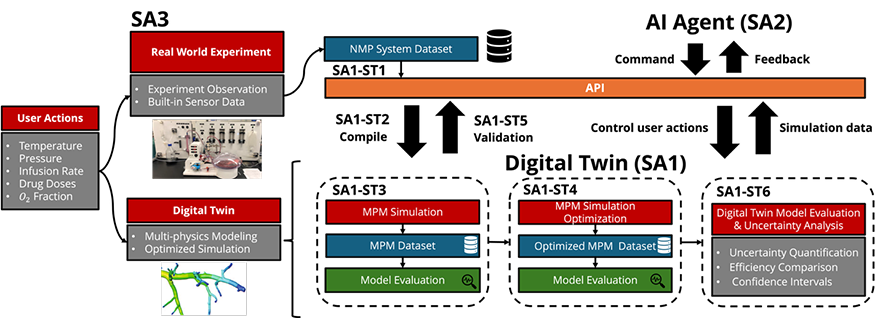From donor to digital: making multi-structure transplants smarter and safer
Jessica Zhang is using AI and digital twins to make limb transplants safer, more accessible, and better matched for the millions of Americans living with limb loss.
For the estimated 1.2 million Americans living with limb loss, transplants offer a renewed opportunity for function, independence, and quality of life. Why then are fewer than four VCA transplants performed across the U.S. annually?
Vascularized Composite Allograft (VCA) transplantation is a complex procedure that requires highly specialized surgical teams to preserve and reconnect multiple types of tissue including skin, muscle, bone, blood vessels, and nerves. Similar to other types of transplants, recipients must take lifelong immunosuppressant medication to prevent their body from rejecting the transplant. However, the complexity of this multi–tissue procedure makes it more difficult for surgeons to preserve and accurately assess the viability of the tissue to predict acceptance.
With the goal of making transplants more accessible and better matched, Jessica Zhang, professor of mechanical engineering at is leveraging AI to assist autonomous monitoring and keep donor limbs alive outside of the body.
In collaboration with the originating PI John Brassil at Functional Circulation LLC, Dr. Byoung Chol Oh at Johns Hopkins School of Medicine and Dr. Xiangliang Zhang at University of Notre Dame, Zhang’s team will use normothermic machine perfusion (NMP), a process that pumps donor limbs with warm, blood-like fluid to keep them alive by simulating conditions inside the body. Unlike cold storage, which can only preserve an organ for four to six hours, NMP has the potential to extend that timeline. However, NMP alone cannot capture the complexity of real, physiologic life.
We believe this process could revolutionize how donor limbs are preserved and transplanted to help more people impacted by limb loss regain function and quality of life.
Jessica Zhang, Professor, Mechanical Engineering
To generate scenarios more reflective of the real world, the team is developing a digital twin of the donor limb that can respond in real-time to NMP and millions of other limb-preservation scenarios. This digital twin will be used to train an AI agent to autonomously monitor and control things like oxygen flow, pressure, and temperature to ensure the limb can remain viable for longer, under more lifelike conditions.
To test the system, the collaborative teams at Functional Circulation LLC and Johns Hopkins will preserve and transplant pig hindlimbs. One limb will be monitored manually by clinicians, the other by the AI agent. After 24 hours of preservation, the limbs will be transplanted onto recipient pigs and observed for 30 days to compare outcomes.
“Our goal is to make transplants safer for patients and easier for surgeons,” said Zhang. “By extending preservation time and giving doctors a tool to fully understand tissue viability before transplantation, we can better match patients to donor limbs. We believe this process could revolutionize how donor limbs are preserved and transplanted to help more people impacted by limb loss regain function and quality of life.”

Pipeline of three specific aims showing the connection and data flow between digital twin (Aim 1), AI agent (Aim 2) and real world experiments (Aim 3). The image under the SA3 block include a VCA experiment conducted by our research team.
This work is supported by the Office of the Assistant Secretary of Defense for Health Affairs through the Reconstructive Transplant Research Program under Award No. HT9425-25-1-0821. Opinions, interpretations, conclusions and recommendations are those of the author and are not necessarily endorsed by the Assistant Secretary of Defense for Health Affairs or the Department of Defense.
